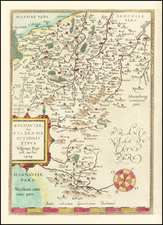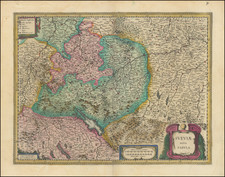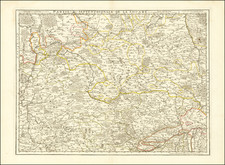Interesting early 18th-century map of southwestern Germany, published by one of London's leading mapmakers, Herman Moll.
The map captures the intricate geographical and political landscape of southwest Germany and adjacent regions during the early 18th century. The geographical spectrum of the map spans from Franconia in the north, Swabia and Alsace to the south, extending westward into the Duchy of Lorraine. The map also includes the major roads in the region.
Starting with Franconia, this region holds an array of smaller towns and cities, each with their unique culture and history. It's delineated by the Main River flowing in a meandering path, the banks of which were home to a thriving agricultural community during this era.
Southwards, the terrain changes as you enter the highlands and wooded valleys of Swabia. The region, known for its distinct dialect and cultural identity, is presented with a number of settlements dotting the map, signifying the life and activity of the period.
The Rhine River, one of the key features of the map, offers an east-west divide. It serves as the main artery for commerce and transportation. Its course is marked by several significant cities, each with its own political and economic importance. One such city is the Electorate of the Palatinate, a historically significant region known for its rich political history.
The political influence of the church during this era cannot be overstated. The presence of the Archbishops and Electors of Mentz and Treves is clearly marked. They held significant influence not just within the church hierarchy but also within the Holy Roman Empire's political structure.
Further west, the map shows Alsace, a cultural melting pot that has historically been a point of contention between French and German influences. Its chief city, Strasbourg, was a hub for commerce and culture during this time.
Finally, the Duchy of Lorraine in the west is highlighted, another significant region during this era, which often found itself at the intersection of French and German political maneuvering.
Herman Moll (c. 1654-1732) was one of the most important London mapmakers in the first half of the eighteenth century. Moll was probably born in Bremen, Germany, around 1654. He moved to London to escape the Scanian Wars. His earliest work was as an engraver for Moses Pitt on the production of the English Atlas, a failed work which landed Pitt in debtor's prison. Moll also engraved for Sir Jonas Moore, Grenville Collins, John Adair, and the Seller & Price firm. He published his first original maps in the early 1680s and had set up his own shop by the 1690s.
Moll's work quickly helped him become a member of a group which congregated at Jonathan's Coffee House at Number 20 Exchange Alley, Cornhill, where speculators met to trade stock. Moll's circle included the scientist Robert Hooke, the archaeologist William Stuckley, the authors Jonathan Swift and Daniel Defoe, and the intellectually-gifted pirates William Dampier, Woodes Rogers and William Hacke. From these contacts, Moll gained a great deal of privileged information that was included in his maps.
Over the course of his career, he published dozens of geographies, atlases, and histories, not to mention numerous sheet maps. His most famous works are Atlas Geographus, a monthly magazine that ran from 1708 to 1717, and The World Described (1715-54). He also frequently made maps for books, including those of Dampier’s publications and Swift’s Gulliver’s Travels. Moll died in 1732. It is likely that his plates passed to another contemporary, Thomas Bowles, after this death.










![[First Postwar Elections In West Germany] Resultats Par District Des Elections En Baviere](https://storage.googleapis.com/raremaps/img/small/78817.jpg)


![[Rhine River -- Strasbourg to the Mosel] Die Ander Tafel Det Rheinstroms begreiffend die Pfaltz/Westerich/Eysel etc.](https://storage.googleapis.com/raremaps/img/small/91195.jpg)
![Palatinatus Bavariae Descriptio . . . [with] Wirtenbergensis Ducatus...](https://storage.googleapis.com/raremaps/img/small/65838.jpg)